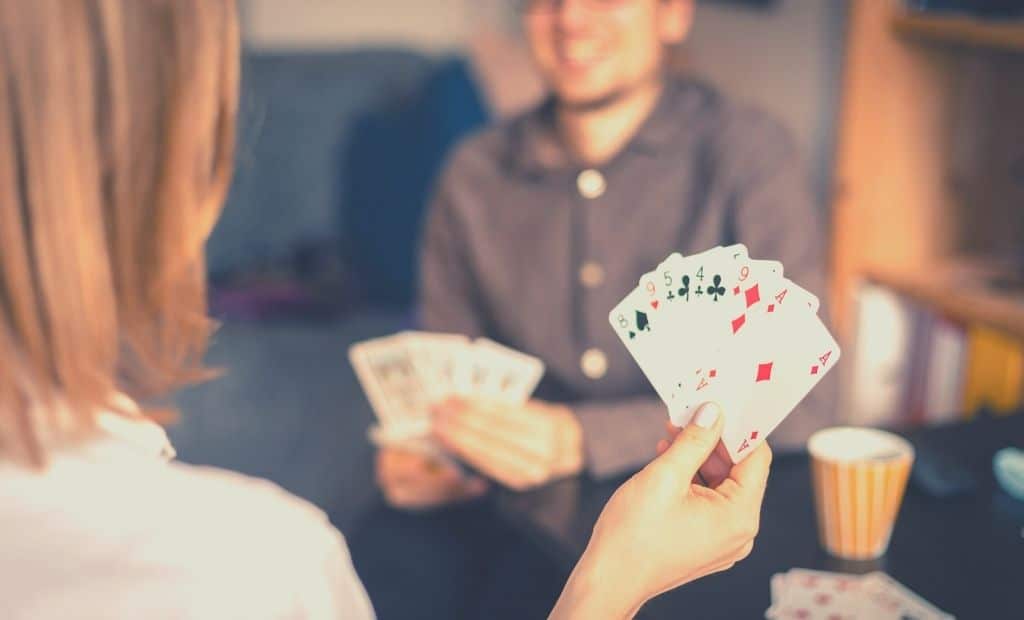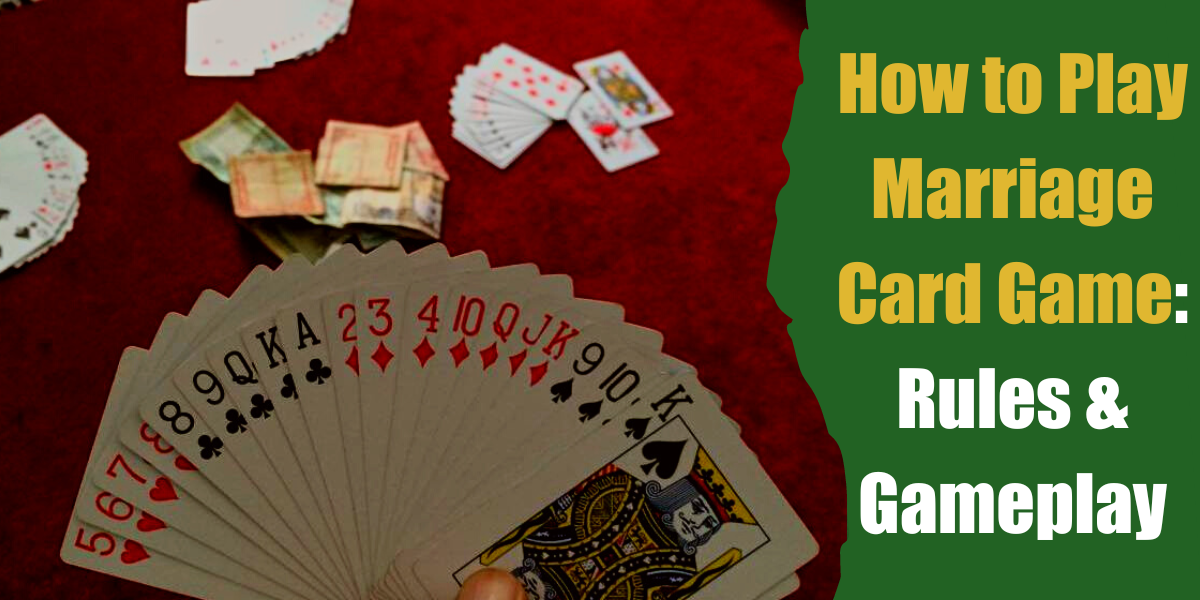The marriage card game is a popular game that originates from Nepal and South Asia. The game requires quick thinking, attention to detail, and a good memory, as you match cards to create sequences.
If you’ve ever played rummy card games, you’ll notice a few similarities in this matching card game, as it’s thought that is where marriage stemmed from initially.
To play the marriage card game, you will need three decks of cards, which nowadays you can pick up from most game stores in a wide variety of designs. I like this gold deck of cards from Amazon; not only do they make a great talking piece on game night, but they’re also waterproof, making them perfect for traveling or camping trips.
However, if these don’t pique your interest, check out my guide to the best luxury & most elegant playing cards to enhance your experience.
Throughout this guide, I will lead you through the rules and steps of gameplay so that by the time you reach the end, you’ll be equipped with all the knowledge you need to bring the marriage card game to your next social gathering.
Aim of the Game
The main goal of the marriage card game is to arrange all your cards into sets, which I will discuss in the next section. The game is won after three stages, making sets, bringing the game to a close, and scoring more points than the rest of the players.
Sets
In the game, two sets can be made, primary (or pure) and secondary (or dirty). Primary is the first two or three sets and can be made using only tunnel or pure sequences. Secondary sets can be built of pure sequences, tunnels, sequences, trials, or dirty trials. Hangfire, I’ll tell you about what these are now.
Sets can consist of the following:
- Sequence – Three or more cards of the same suit, in consecutive order, containing at least one wildcard.
- Pure Sequence – The same as above, but with no wildcards.
- Trial – Three cards or more of different suits but of the same rank.
- Dirty Trial – Same as above, with the inclusion of a wildcard.
- Tunnel – Three cards that must be the same suit and rank. If you have one after the first deal, it’s worth five points and must be shown before the first player takes a card from the stock deck. If you don’t do this, your tunnel is void.
- Dublee – Two cards of the same suit and rank. If you receive seven of these, it’s the same as a pure sequence.
Marriage Card Game – The Deal

It’s down to you how you pick who will be the dealer for your game. You could draw cards to see who gets the highest or go with the oldest or youngest person in the group – use your imagination. However, after the initial deal, the player seated to the left of the first dealer deals next, and so on.
Twenty-one cards are dealt to each player one at a time. Before upturning one card and placing the rest in the middle of the table, this will be your stockpile, and the upturned card will be the discard pile.
The difference in this game is that the discard pile is not a pile. All discarded cards are placed in a way that they’re all visible throughout the game. However, when it comes to taking a discarded card, you may only take the one that was discarded by the player before you.
If you have a tunnel in your initial deck, three identical cards, you should show these to the rest of the players, earning you five points straight away. If you forget to expose it at the start of the game, or it appears later on, the value is lost.
Marriage – Rules & Gameplay

The person sitting to the dealer’s left takes the first turn, and the game then moves in a clockwise direction.
The turns consist of players taking the top card from the stockpile or the turned-up card from the discard pile; don’t forget, in marriage, the discard pile is not really a pile but instead discarded cards that are all visible throughout the game. It would help if you then decided which card from your hand to discard yourself. However, you are not allowed to discard the card you picked up from the discard pile.
The game continues in this way until specific criteria have been met, which I will talk more about in the “ending the game” section of this guide.
First, let’s take a more in-depth look at the rounds, wildcards, and point cards.
Primary/Pure Rounds
During each turn, you’ll attempt to make three primary sets. When you do this, you display your sets to the rest of the players by placing the face up before discarding a card. The first person to complete this can pick a card randomly from the deck and place it at the bottom of the pile. This is now the main maal, known as the tiplu card. The other players can only take a peek at this if they, too, can complete a primary set; however, they cannot change it.
If you manage to get seven dublees, this also counts as a primary set, and these must also be placed down for everyone else to see.
Secondary/Dirty Rounds
If you finish a primary round, you can move on to the secondary round, or dirty round, if you will. At which point you will already know what the main maal is. You may start introducing wildcards to your sets at this point.
Wildcards can be used in place of any other card to form a set and come in two categories, point cards, and non-point cards. For the following examples, let’s say that the six hearts is the tiplu card.
Here’s a bit more information on what those wildcards are and how they are scored:
Point Cards/Maal Cards
- Tiplu: The main maal card, which a player who completed a set took from the stockpile and placed at the bottom of the deck. This has an additional value of three points. As there are three decks of cards used in the game, there will be three tiplu cards per game.
- Jokers/Putali: Jokers are worth five points each. These are optional in standard play and can be used as a wildcard instead of any other card in a set.
- Jhiplu: This is the card below the tiplu card that is of the same suit. It’s worth two points and can be used as a wildcard. In this case, that would be the five of hearts.
- Poplu: This is the card above the main maal, the seven of hearts. The poplu is worth two points and can be used as a wildcard.
- Alter: The alter is any card with the same rank as the tiplu, in this instance, any red six. These aren’t worth any extra points but can be used as wildcards.
Non-Point Wildcards/Jokers
Any card with the same rank as the tiplu is a wildcard without points. It means that making sets is more achievable but doesn’t affect your score. There will be nine ordinary jokers in the game, which won’t match rank with the tiplu card; in this instance, jokers that are a club, spade, or diamond would not be worth any points but can be used as a wildcard. However, if you’re playing with the altered rule in place, there will be six ordinary jokers.
Ending the Game
The game can be brought to an end in two ways:
- If you place down three sets of either tunnels or sequences, you can draw a card and see if you can form four more combinations. If you can, these can be played down, and the final card discarded, ending the game.
- If you have eight dublees after drawing, you can lay these out, immediately bringing the game to a close.
The only cards throughout the game entitle you to see the main maal and tunnels after the first draw.
Scoring
If you’re the one to end the game, you will get ten points from the other players who haven’t completed primary rounds. You will also get three points from each player who did complete a primary round.
The points are scored as follows:
| Tunnel | 5 points |
| Joker Tunnel | 10 points |
| People | 20 points |
| Jhiplu | 20 points |
| Alter | 35 points |
| Double Bonus | 5 points |
| Triple Bonus | 35 points |
Each player loses or wins points based on three factors:
- The round in which was played
- How many point cards the player has (+)
- How many point cards do other players have (-)
So, that’s how you play the marriage card game from start to finish; if you’ve enjoyed learning about this matching card game, then you should take a look at some other types of card games, such as The Fox in the Forest, a great trick-taking game for two players, or why not a classic game of Uno?


